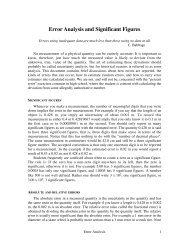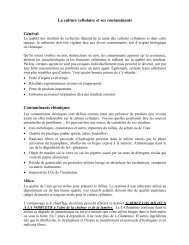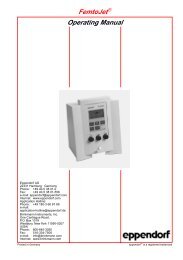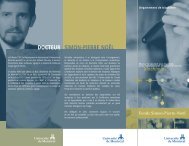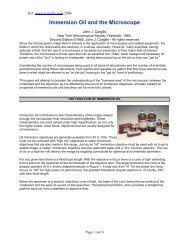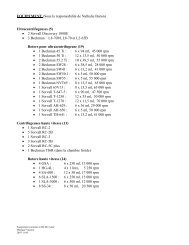Basics of Light Microscopy Imaging - AOMF
Basics of Light Microscopy Imaging - AOMF
Basics of Light Microscopy Imaging - AOMF
You also want an ePaper? Increase the reach of your titles
YUMPU automatically turns print PDFs into web optimized ePapers that Google loves.
Each voxel <strong>of</strong> a three-dimensional object<br />
has a colour. There are several wellknown<br />
methods for volume rendering,<br />
such as projection and ray casting. These<br />
approaches project the three-dimensional<br />
object onto the two-dimensional viewing<br />
plane. The correct volume generating<br />
method guarantees that more than just<br />
the outer surface is shown and that the<br />
three-dimensional object is not displayed<br />
simply as a massive, contourless block.<br />
Inner structures within a three-dimensional<br />
object, such as fluorescence signals<br />
can be visualised. The maximum intensity<br />
projection method looks for the<br />
brightest voxel along the projection line<br />
and displays only this voxel in the two-dimensional<br />
view. Fig. 62 shows the maximum<br />
intensity projection <strong>of</strong> two colour<br />
channels <strong>of</strong> 25 frames each when seen<br />
from two different angles. Changing the<br />
perspective helps to clearly locate the fluorescence<br />
signals spatially. The three-dimensional<br />
structure will appear more realistic<br />
when the structure rendered into<br />
three-dimensions is rotated smoothly.<br />
How many are there – One or Two<br />
Managing several colour channels (each<br />
having many z layers) within one image<br />
object can be deceptive. The question is<br />
whether two structures appearing to<br />
overlap are actually located at the same<br />
position spatially or whether one is in fact<br />
behind the other. The thing is, two fluorescence<br />
signals may overlap – because<br />
their mutual positions are close to each<br />
other within the specimen. This phenomenon<br />
is called colocalisation. It is encountered<br />
when multi-labelled molecules bind<br />
to targets that are found in very close or<br />
spatially identical locations.<br />
Volume rendering makes it possible to<br />
locate colocalised structures in space visually.<br />
For better representation and in<br />
order to measure colocalisation in digital<br />
image objects, the different fluorescence<br />
signals are first distinguished from the<br />
background. This may be done via<br />
Table 4:<br />
threshold setting in each <strong>of</strong> the colour<br />
channels. A new image object can be created<br />
with only those structures that were<br />
highlighted by the thresholds. The colocalised<br />
fluorescence signals are displayed<br />
in a different colour. Rendering these image<br />
objects clearly reveals the colocalised<br />
signals without any background disturbance.<br />
To obtain quantitative results,<br />
the area fraction <strong>of</strong> the colocalised signals<br />
compared to the total area <strong>of</strong> each<br />
<strong>of</strong> the two fluorescence signals can be<br />
calculated throughout all image sections<br />
(see table 4).<br />
Layer Red Green Colocalisation Colocalisation/Red Colocalisation/Green<br />
Area[%] Area[%] Area[%] Ratio[%] Ratio[%]<br />
1.00 0.11 0.20 0.04 39.60 21.22<br />
2.00 0.15 0.26 0.07 47.76 27.92<br />
3.00 0.20 0.36 0.10 49.93 28.08<br />
4.00 0.26 0.53 0.13 51.84 25.32<br />
5.00 0.35 1.34 0.20 57.39 14.87<br />
6.00 0.43 2.07 0.26 61.00 12.81<br />
7.00 0.38 1.96 0.24 61.66 12.07<br />
Colocalisation sheet: A ratio value <strong>of</strong> about 52 % in the Colocalisation/Red column in layer 4 means<br />
that 52 % <strong>of</strong> red fluorescence signals are colocalised with green fluorescent structures here.<br />
Fig. 59: Confocal images <strong>of</strong> pollen. The upper rows show the first 12 images <strong>of</strong> a series <strong>of</strong> 114, that<br />
can be used to create either two-dimensional projections <strong>of</strong> parts <strong>of</strong> the pollen or create a 3D view <strong>of</strong><br />
the surface structure. This three-dimensional projection shown here is accompanied by two-dimensional<br />
projections as if the pollen was being viewed from different perspectives. Images were created<br />
using the Olympus Fluoview 1000.<br />
3-D reconstructions<br />
Now let us draw the net wider and move<br />
for a minute beyond the light microscopy<br />
approaches in imaging three-dimensional<br />
objects. In general. determining<br />
three-dimensional structures from macro<br />
to atomic level is a key focus for current<br />
biochemical research. Basic biological<br />
processes, such as DNA metabolism, photosynthesis<br />
or protein synthesis require<br />
the coordinated actions <strong>of</strong> a large number<br />
<strong>of</strong> components. Understanding the threedimensional<br />
organisation <strong>of</strong> these components,<br />
as well as their detailed atomic<br />
structures, is crucial to being able to interpret<br />
what their function is.<br />
In the materials science field, devices<br />
have to actually „see“ to be able to measure<br />
three-dimensional features within<br />
materials, no matter how this is done:<br />
whether structurally, mechanically, electrically<br />
or via performance. However, as<br />
the relevant structural units have now<br />
moved to dimensions less than a few<br />
hundred nanometres, obtaining this<br />
three-dimensional data means new<br />
methods have had to be developed in order<br />
to be able to display and analyse<br />
46 • <strong>Basics</strong> <strong>of</strong> light <strong>Microscopy</strong> & <strong>Imaging</strong> 3D <strong>Imaging</strong>




